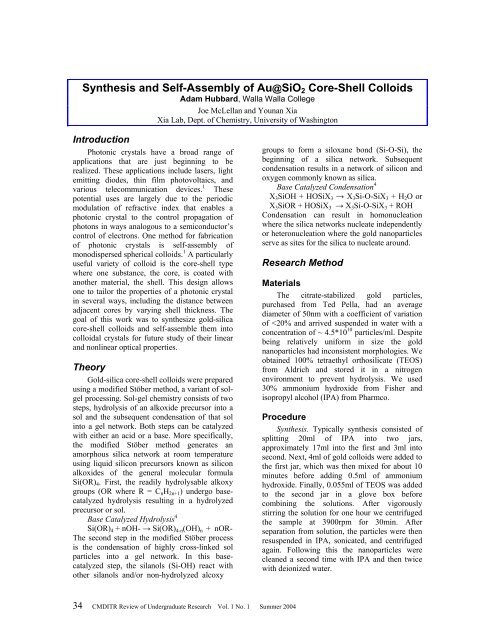CMDITR Review of Undergraduate Research - Pluto - University of ...
CMDITR Review of Undergraduate Research - Pluto - University of ...
CMDITR Review of Undergraduate Research - Pluto - University of ...
You also want an ePaper? Increase the reach of your titles
YUMPU automatically turns print PDFs into web optimized ePapers that Google loves.
Synthesis and Self-Assembly <strong>of</strong> Au@SiO 2 Core-Shell Colloids<br />
Adam Hubbard, Walla Walla College<br />
Joe McLellan and Younan Xia<br />
Xia Lab, Dept. <strong>of</strong> Chemistry, <strong>University</strong> <strong>of</strong> Washington<br />
Introduction<br />
Photonic crystals have a broad range <strong>of</strong><br />
applications that are just beginning to be<br />
realized. These applications include lasers, light<br />
emitting diodes, thin film photovoltaics, and<br />
various telecommunication devices. 1 These<br />
potential uses are largely due to the periodic<br />
modulation <strong>of</strong> refractive index that enables a<br />
photonic crystal to the control propagation <strong>of</strong><br />
photons in ways analogous to a semiconductor’s<br />
control <strong>of</strong> electrons. One method for fabrication<br />
<strong>of</strong> photonic crystals is self-assembly <strong>of</strong><br />
monodispersed spherical colloids. 1 A particularly<br />
useful variety <strong>of</strong> colloid is the core-shell type<br />
where one substance, the core, is coated with<br />
another material, the shell. This design allows<br />
one to tailor the properties <strong>of</strong> a photonic crystal<br />
in several ways, including the distance between<br />
adjacent cores by varying shell thickness. The<br />
goal <strong>of</strong> this work was to synthesize gold-silica<br />
core-shell colloids and self-assemble them into<br />
colloidal crystals for future study <strong>of</strong> their linear<br />
and nonlinear optical properties.<br />
Theory<br />
Gold-silica core-shell colloids were prepared<br />
using a modified Stöber method, a variant <strong>of</strong> solgel<br />
processing. Sol-gel chemistry consists <strong>of</strong> two<br />
steps, hydrolysis <strong>of</strong> an alkoxide precursor into a<br />
sol and the subsequent condensation <strong>of</strong> that sol<br />
into a gel network. Both steps can be catalyzed<br />
with either an acid or a base. More specifically,<br />
the modified Stöber method generates an<br />
amorphous silica network at room temperature<br />
using liquid silicon precursors known as silicon<br />
alkoxides <strong>of</strong> the general molecular formula<br />
Si(OR) 4 . First, the readily hydrolysable alkoxy<br />
groups (OR where R = C n H 2n+1 ) undergo basecatalyzed<br />
hydrolysis resulting in a hydrolyzed<br />
precursor or sol.<br />
Base Catalyzed Hydrolysis 4<br />
Si(OR) 4 + nOH- → Si(OR) 4-n (OH) n + nOR-<br />
The second step in the modified Stöber process<br />
is the condensation <strong>of</strong> highly cross-linked sol<br />
particles into a gel network. In this basecatalyzed<br />
step, the silanols (Si-OH) react with<br />
other silanols and/or non-hydrolyzed alcoxy<br />
groups to form a siloxane bond (Si-O-Si), the<br />
beginning <strong>of</strong> a silica network. Subsequent<br />
condensation results in a network <strong>of</strong> silicon and<br />
oxygen commonly known as silica.<br />
Base Catalyzed Condensation 4<br />
X 3 SiOH + HOSiX 3 → X 3 Si-O-SiX 3 + H 2 O or<br />
X 3 SiOR + HOSiX 3 → X 3 Si-O-SiX 3 + ROH<br />
Condensation can result in homonucleation<br />
where the silica networks nucleate independently<br />
or heteronucleation where the gold nanoparticles<br />
serve as sites for the silica to nucleate around.<br />
<strong>Research</strong> Method<br />
Materials<br />
The citrate-stabilized gold particles,<br />
purchased from Ted Pella, had an average<br />
diameter <strong>of</strong> 50nm with a coefficient <strong>of</strong> variation<br />
<strong>of</strong>




